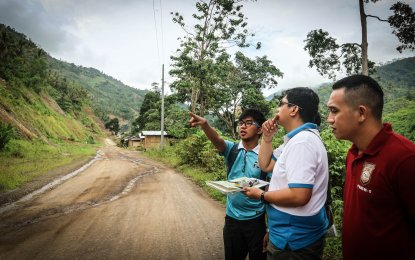
DAVAO CITY – Geologists from the Philippine Institute of Volcanology and Seismology (Phivolcs) placed markers in several fault lines in Davao Oriental sighted in some portions of Mati City and Lupon town which reportedly sitting on top of the Philippine Faultline.
The areas transected by faultlines included portion of barangays Marayag, Calapagan, and Don Marcelino in Lupon and portions of Barangays Taguibo, Sainz and Central in Mati.
This was reported Sunday by Davao Oriental Provincial Information Officer Karen Lou Deloso based on the three-day activity “Walk the Fault” by Phivolcs geologists led by Jeffrey Perez.
Based on the Phivolcs findings, Deloso said the fault in Davao Oriental approximately 30 kilometers long is connected to the Philippine Fault line – the longest fault in the Philippines that stretches up to 1,200 kilometers from Luzon down to Mindanao.
Phivolcs noted that 320 kilometers of which is located in Eastern Mindanao stretching from Surigao area to Mati.
At the end of the three-day activity, Deloso said the Phivolcs team put markers which would guide local leaders especially in the barangays to inform residents on the need to take precautions and preparations.
Phivolcs also reported no fault lines in heavily or densely populated areas in Mati. But residents are still encouraged to keep safe from the hazards of earthquake which includes groundshaking that usually results in injuries, fatalities and destruction of buildings; landslides, and tsunami.
The three-day mapping of fault lines in earthquake hotspots in the provinces was aimed to save lives by making residents and local officials inculcate a culture of safety, telling them to be aware on the location and trace of the fault lines especially those underneath settlements that might drastically be affected by massive earthquakes.
Deloso said the activity was requested by Governor Nelson Dayanghirang as part of the province’s mitigation and preparedness
Dayanghirang had underlined the activity as something that does not intend to cause alarm, but to promote awareness and safety to lessen damages and casualty when disaster strikes.
Areas in fault lines are considered danger zones and classified as no-build zone areas. Structures built in faults should be built five meters from the faultline on both sides.
Experts said the Philippine Fault Zone divides the country from Luzon to Southern Mindanao with its tail end located in Mati, Davao Oriental. It is in the path of the Ring of Fire, a 40,000-km horseshoe-shaped continuous area in the basin of the Pacific Ocean where a large number of earthquakes and volcanic eruptions occur. (Lilian C. Mellejor/PNA)
